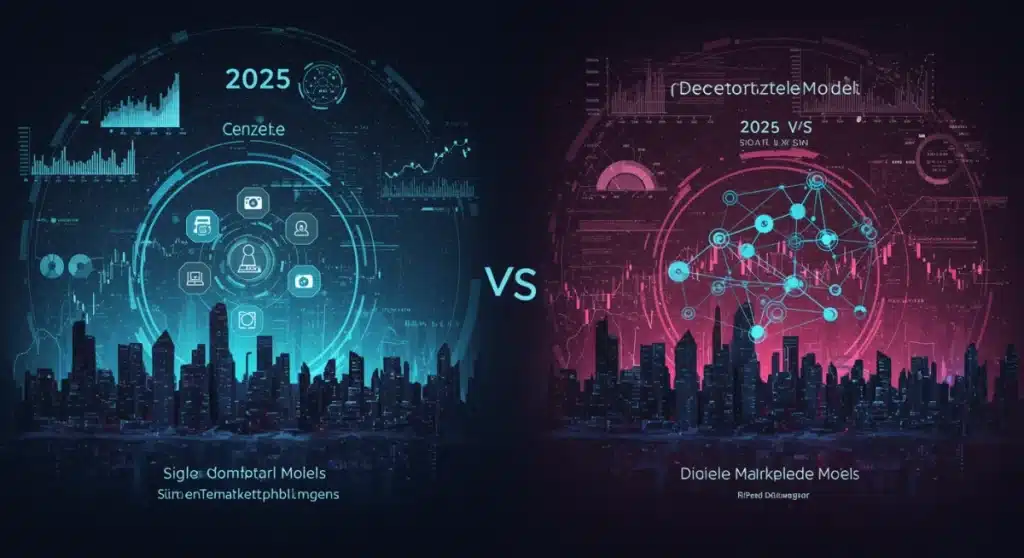Centralized vs. Decentralized Marketplaces: 2025 Economic Efficiency

The economic efficiency of centralized versus decentralized digital marketplaces in 2025 presents a critical debate, with centralized platforms offering scale and established infrastructure, while decentralized alternatives promise transparency, reduced intermediation, and enhanced user control, each with distinct cost and benefit profiles.
Comparing the Economic Efficiency of Centralized vs. Decentralized Digital Marketplaces in 2025 (COMPARISON/ANALYSIS) is shaping today’s digital economy landscape. This analysis delves into the core mechanics, advantages, and drawbacks of each model, providing crucial insights into their operational viability and future trajectory in a rapidly evolving market. Understanding these dynamics is essential for businesses and consumers alike.
Understanding Centralized Digital Marketplaces in 2025
Centralized digital marketplaces, such as Amazon, eBay, and Apple’s App Store, continue to dominate the e-commerce and digital service sectors. These platforms operate under a single entity that controls all aspects of transactions, from user registration and payment processing to dispute resolution and content moderation. Their economic efficiency stems largely from economies of scale, established trust mechanisms, and robust infrastructure built over years.
In 2025, these marketplaces leverage advanced AI for personalization, predictive analytics for supply chain optimization, and sophisticated cybersecurity measures. This allows them to offer a seamless user experience, a vast array of products, and reliable transaction processing. The concentrated power enables rapid decision-making and efficient resource allocation, often resulting in lower per-transaction costs due to high volume.
Key Economic Advantages of Centralized Platforms
- Scalability and Reach: Centralized platforms can quickly scale their operations to accommodate millions of users and transactions globally, leveraging extensive server farms and global distribution networks. This reach provides sellers with immediate access to a massive customer base.
- Established Trust and Regulation: Users often trust centralized platforms due to their brand recognition, established customer service, and compliance with regulatory frameworks. This reduces transaction friction and builds consumer confidence, a critical factor for online commerce.
- Streamlined Operations: With a single point of control, these marketplaces can implement standardized processes for onboarding, payments, and logistics, leading to operational efficiencies and easier integration for third-party sellers.
However, this centralized control also comes with potential downsides, including higher commission fees, data privacy concerns, and the risk of single points of failure. The economic model prioritizes the platform’s profitability, often at the expense of individual seller autonomy or competitive pricing that might emerge in a more open system.
The Rise of Decentralized Digital Marketplaces
Decentralized digital marketplaces, often built on blockchain technology, represent a burgeoning alternative. These platforms aim to eliminate intermediaries by enabling direct peer-to-peer transactions, thereby distributing control and ownership among participants. In 2025, advancements in blockchain scalability and interoperability are making these models increasingly viable.
The core promise of decentralization lies in reduced transaction costs, enhanced transparency, and greater control for users over their data and assets. By utilizing smart contracts, many processes that typically require human oversight in centralized systems are automated and executed immutably on a distributed ledger. This fundamental shift challenges the traditional economic structures of digital commerce.
Core Principles Driving Decentralized Efficiency
- Reduced Intermediation: By removing central authorities, decentralized marketplaces can significantly cut down on transaction fees, which typically go to the platform operator. This directly benefits both buyers and sellers, potentially leading to more competitive pricing.
- Transparency and Immutability: All transactions are recorded on a public, immutable ledger, offering unprecedented transparency. This can build trust through verifiable records rather than relying on a central entity’s reputation.
- User Control and Data Privacy: Participants retain greater control over their data and digital identities. This aligns with a growing demand for data sovereignty, allowing users to choose how their information is used and shared.
While still in their nascent stages compared to their centralized counterparts, decentralized marketplaces are rapidly evolving. Their economic efficiency is not just about cost savings but also about resilience, censorship resistance, and fostering a more equitable distribution of value among participants.
Cost Structures: Centralized vs. Decentralized
A direct comparison of cost structures reveals fundamental differences in the economic efficiency of both models. Centralized marketplaces incur significant costs in infrastructure maintenance, cybersecurity, marketing, customer support, and regulatory compliance. These overheads are typically passed on to users through commissions, listing fees, and advertising costs.
Decentralized marketplaces, by contrast, often have lower operational overheads. The distributed nature of blockchain networks means that infrastructure costs are shared among nodes, and smart contracts automate many administrative tasks. However, they face different cost challenges, such as development complexity, network transaction fees (gas fees), and the need for robust decentralized governance mechanisms.

For example, a centralized platform might charge a 15-30% commission on sales, whereas a decentralized platform might only incur a small network fee for each transaction, often a fraction of a percent. The trade-off often involves the level of service and trust guarantees. Centralized platforms offer a safety net and professional support, while decentralized ones rely on community-driven solutions and cryptographic guarantees.
The economic efficiency in terms of cost is a nuanced discussion. While decentralized options present lower direct transaction costs, the indirect costs associated with user adoption, security vulnerabilities, and less mature dispute resolution systems can sometimes offset these savings. As blockchain technology matures, these indirect costs are expected to decrease, improving the overall economic efficiency of decentralized models.
Performance Metrics and User Experience in 2025
When assessing digital marketplace efficiency, performance metrics and user experience are paramount. Centralized platforms excel in user-friendliness, offering intuitive interfaces, quick search capabilities, and integrated payment systems. Their extensive resources allow them to invest heavily in UX/UI design, data-driven personalization, and high-speed performance, leading to high user retention and conversion rates.
Decentralized marketplaces, while improving, still face challenges in matching the seamless experience of their centralized counterparts. The learning curve for blockchain-based applications can be steeper, and transaction speeds, though increasing, may not always rival traditional systems. However, the benefits of censorship resistance and true ownership resonate deeply with a segment of users, driving adoption despite current UI complexities.
Key Performance Differentiators
- Transaction Speed: Centralized platforms typically process transactions instantaneously, benefiting from centralized servers and established financial rails. Decentralized networks depend on block confirmation times, which can vary.
- Scalability: While centralized systems scale by adding more servers, decentralized networks scale through protocol improvements (e.g., sharding, layer-2 solutions), which are continuously evolving in 2025 to handle higher transaction volumes.
- Security and Trust: Centralized platforms rely on corporate security and legal frameworks. Decentralized platforms offer cryptographic security and transparent, immutable records, reducing the need for trust in a single entity.
The future economic efficiency of both models will largely depend on their ability to adapt and innovate in these areas. Centralized platforms must address growing demands for data privacy and fair competition, while decentralized platforms must overcome usability hurdles and achieve mass adoption to fully realize their economic potential.
Innovation and Future Outlook
Innovation continues to drive the evolution of both centralized and decentralized digital marketplaces. Centralized platforms are exploring Web3 integrations, such as NFTs for digital collectibles and loyalty programs, to maintain relevance and attract new users. They are also investing in metaverse experiences and enhanced augmented reality shopping to create immersive retail environments.
Decentralized marketplaces, on the other hand, are at the forefront of Web3 innovation. They are pioneering new forms of governance through DAOs (Decentralized Autonomous Organizations), enabling community ownership and decision-making. The integration of decentralized identity solutions and self-sovereign data management promises a future where users have unprecedented control over their digital lives and economic interactions.

The economic efficiency in 2025 is not a static measure but a dynamic interplay of technological advancement, regulatory landscape, and user preference. Centralized platforms are likely to retain their market share due to their convenience and established user bases, but they will face increasing pressure to adopt more transparent and user-centric policies. Decentralized platforms, while starting from a smaller base, are expected to grow significantly, especially as blockchain technology becomes more user-friendly and regulatory clarity emerges.
The convergence of these models, where centralized platforms integrate decentralized components or vice-versa, could also be a significant trend. This hybrid approach might offer the best of both worlds: the efficiency and scalability of centralized systems with the transparency and user control of decentralized ones.
Challenges and Regulatory Landscape for Digital Marketplaces
Both centralized and decentralized digital marketplaces face significant challenges and operate within a complex regulatory environment in 2025. Centralized platforms are under intense scrutiny regarding antitrust concerns, data monopolies, and content moderation policies. Governments worldwide are imposing stricter regulations on data privacy (like GDPR and CCPA) and market competition, potentially impacting their economic models and operational flexibility.
Decentralized marketplaces encounter their own set of regulatory hurdles. The lack of a central authority makes it difficult to assign responsibility for illicit activities, leading to concerns about money laundering, fraud, and consumer protection. Regulators are grappling with how to classify and govern decentralized autonomous organizations (DAOs) and digital assets, creating an environment of uncertainty that can hinder adoption and investment.
Navigating the Regulatory Maze
- Centralized Platform Concerns: Antitrust investigations, data privacy fines, and demands for greater transparency in algorithms and pricing models are prevalent. These can lead to significant compliance costs and operational restrictions.
- Decentralized Platform Hurdles: Regulatory ambiguity around tokenomics, KYC/AML compliance in a borderless environment, and consumer protection without a central entity for recourse are major challenges.
The economic efficiency of either model is inextricably linked to its ability to navigate these challenges. Centralized platforms may see their efficiency reduced by compliance costs and potential breakups, while decentralized platforms could unlock massive efficiency gains if a clear and favorable regulatory framework emerges. The balance between innovation and regulation will be a defining factor in their respective economic trajectories.
Key Aspect |
Economic Implication |
|---|---|
Cost Structure |
Centralized: High overheads, commission-based. Decentralized: Lower direct fees, network transaction costs. |
Scalability |
Centralized: Proven, rapid expansion. Decentralized: Evolving through tech advancements (e.g., Layer 2). |
User Trust |
Centralized: Brand reputation, customer service. Decentralized: Cryptographic security, transparency. |
Regulatory Impact |
Centralized: Antitrust, data privacy compliance. Decentralized: Regulatory ambiguity, compliance challenges. |
Frequently Asked Questions About Digital Marketplace Efficiency
▼
Centralized marketplaces achieve economic efficiency through economies of scale, robust infrastructure, and streamlined operations. Their ability to handle massive transaction volumes and offer integrated services at scale often leads to lower per-unit operating costs, despite higher commission fees for users.
▼
Decentralized marketplaces primarily derive economic efficiency from reducing intermediaries and automating processes via smart contracts. This minimizes traditional overheads like extensive customer support and large administrative teams, translating into lower transaction fees and greater value retention for participants.
▼
Centralized platforms offer convenience, established trust, and comprehensive support at the cost of higher fees and less user control. Decentralized platforms provide lower fees, transparency, and data sovereignty but often come with a steeper learning curve and evolving infrastructure, impacting immediate user experience.
▼
Yes, blockchain technology is expected to significantly enhance the economic efficiency of decentralized marketplaces by 2025. Improvements in scalability, interoperability, and user-friendly interfaces will make decentralized options more competitive, fostering broader adoption and challenging centralized dominance with transparent and cost-effective alternatives.
▼
Regulation profoundly impacts economic efficiency. Stricter antitrust and data privacy laws can increase operational costs for centralized platforms. Conversely, clearer regulations for decentralized platforms could reduce legal uncertainties, attract more investment, and foster innovation, ultimately improving their perceived and actual economic efficiency.
What this means
The ongoing comparison between centralized and decentralized digital marketplaces in 2025 underscores a fundamental shift in the digital economy. While centralized giants continue to leverage scale, decentralized alternatives are gaining traction by offering transparency and lower transaction costs. Businesses and consumers must weigh the trade-offs between convenience, control, and cost as both models evolve, driving innovation and demanding regulatory clarity to unlock their full economic potential.





